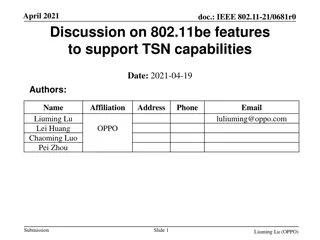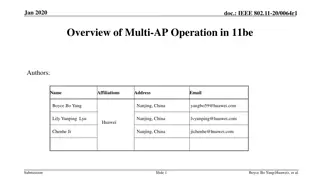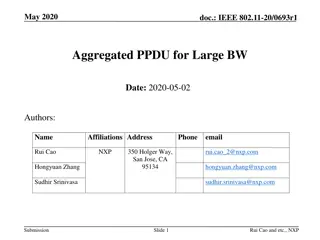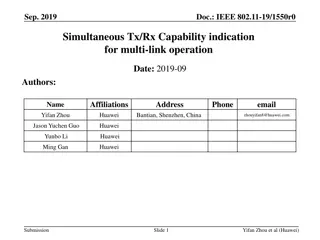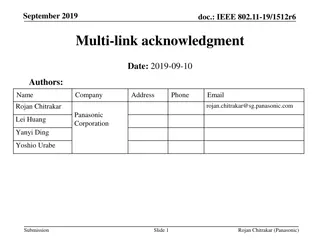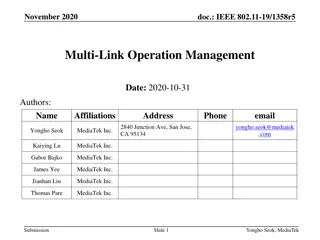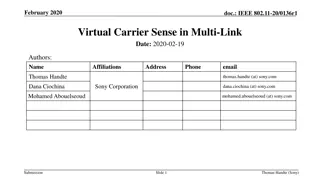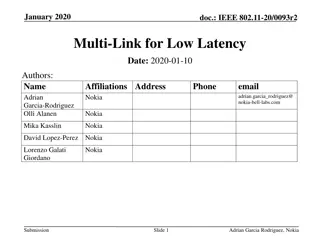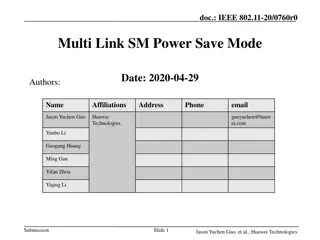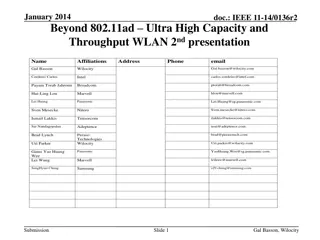IEEE 802.11-17: Enhancing Multi-Link Operation for Higher Throughput
The document discusses IEEE 802.11-17/xxxxr0 focusing on multi-link operation for achieving higher throughput. It covers motions adopted in the SFD related to asynchronous multi-link channel access, mechanisms for multi-link operation, and shared sequence number space. Additionally, it explores the motivation for multi-link devices, proposing methods like BA compression and addressing the overhead challenges for different MCS rates.
Download Presentation

Please find below an Image/Link to download the presentation.
The content on the website is provided AS IS for your information and personal use only. It may not be sold, licensed, or shared on other websites without obtaining consent from the author. Download presentation by click this link. If you encounter any issues during the download, it is possible that the publisher has removed the file from their server.
E N D
Presentation Transcript
January 2020 doc.: IEEE 802.11-17/xxxxr0 Multi-Link BA compression Date: 2020-01-06 Authors: Name Girish Madpuwar Affiliations Broadcom Corporation Broadcom Corporation Address Phone email Matthew Fischer Submission Slide 1 Girish Madpuwar, Broadcom Corp
January 2020 doc.: IEEE 802.11-17/xxxxr0 Background Multi-Link operation is discussed in various presentation for 11be and considered as key feature to achieve higher throughput Following Motion have been adopted in SFD [5] [Motion 20]: 802.11be shall allow the following asynchronous multi-link channel access: Each of STAs belonging to a MLD performs a channel access over their links independently in order to transmit frames. Downlink and uplink frames can be transmitted simultaneously over the multiple links. [Motion 9]: 802.11be define mechanism(s) for multi-link operation that enables the following An operational mode for concurrently exchanging frames on more than one link for one or more TID(s). An operational mode for restricting exchanging frames of one or more TID(s) to be on one link at a time. [Motion 37]: Sequence numbers are assigned from a common sequence number space shared across multiple links of a MLD, for a TID that may be transmitted to a peer MLD over one or more links. Submission Slide 2 Girish Madpuwar, Broadcom Corp
January 2020 doc.: IEEE 802.11-17/xxxxr0 Motivation Multi link device [1][2][4] Concurrently exchange frames on more than one link for one or more TID(s) Can have single Block Ack negotiation for multiple link 802.11be PAR proposes at least one mode of operation capable of supporting a maximum throughput of at least 30 Gbps This may lead to increase in MPDU aggregation The size of Block ACK may increase to support higher aggregation over multi-link Block ACK frames are transmitted at lower rate Increased Block ACK size lead to increased medium utilization Increased medium utilization in tern results into decreased medium efficiency Proposed scheme discusses reduction of Block ACK overhead Submission Slide 3 Girish Madpuwar, Broadcom Corp
January 2020 doc.: IEEE 802.11-17/xxxxr0 Proposal 1: BA compression BA size for single TID Plot shows size of compressed BA for various MCS rate if 11ax compressed BA frame is scaled for 512/1024/2048 and 4096 MPDUs Assumed 11ax preamble (L-STF + L-LTF + L-SIG + RL-SIG + HE-SIG-A + HE-STF + HE-LTF) Plots shows that overhead for lower MCS rates is high For MCS0 512BA is 43% longer than 256BA 1K BA is 101% longer than 256BA 4K BA is 475% longer than 256BA For MCS6 512BA has no overhead 1K BA is 15% longer than 256BA 4K BA is 101% longer than 256BA Submission Slide 4 Girish Madpuwar, Broadcom Corp
January 2020 doc.: IEEE 802.11-17/xxxxr0 Proposal 1: BA compression BA sizes for multi TID Plot shows size of multi-STA BA frame for various MCS rate if 11ax multi-STA BA frame is scaled for 512/1024/2048 and 4096 MPDUs Number of TID assumed 4 for analysis Assumed 11ax preamble (L-STF + L-LTF + L-SIG + RL-SIG + HE-SIG-A + HE-STF + HE-LTF) BA size increase is significant for lower MCS For MCS0 512BA is 60% longer than 256BA 1K BA is 174% longer than 256BA 4K BA is 877% longer than 256BA For MCS6 512BA is 20% longer than 256BA 1K BA is 61% longer than 256BA 4K BA is 283% longer than 256BA Submission Slide 5 Girish Madpuwar, Broadcom Corp
January 2020 doc.: IEEE 802.11-17/xxxxr0 Proposal 2: BA frame format Figure 1 shows compressed BA frame Figure 2 shows multi-STA BA frame For maximum aggregation, Block Ack Bitmap contains 256 bits each representing single MPDU For multi-STA BA if BA acknowledges multiple TID, Per AID TID info contains the 256 bits repeated for each TID. Submission Slide 6 Girish Madpuwar, Broadcom Corp
January 2020 doc.: IEEE 802.11-17/xxxxr0 Proposal 2: 11be Single Layer BA Add new BA Type Compressed Block ACK with (a) Single Layer BA (SLB) and (b) Multi Layer BA (MLB) Multi-STA Block ACK with (a) Single Layer BA (SLB) and (b) Multi Layer BA (MLB) Define new field in BA Control SL compression Size (SLZ) : 8 bits/ 16bits/ 32 bits ML compression Size (MLZ) : 256 bits/ 512 bits/ 1024bits/ 2048 bits Redefine BA bitmap SLB Bitmap should contain {Bitmap SL header, Bitmap Segments} MLB Bitmap should contain {Bitmap ML header, {Bitmap SL header, Bitmap Segments}} BA frame configuration For SLB frame MLZ is reserved; SLZ can be 8 bits/ 16bits/ 32 bits ; For MLB frame MLZ can be 256 bits/ 512 bits/ 1024bits/ 2048 bits ; SLZ can be 8 bits/ 16bits/ 32 bits Note: Field names are symbolic and can be changed to suite overall 11be naming convention Submission Slide 7 Girish Madpuwar, Broadcom Corp
January 2020 doc.: IEEE 802.11-17/xxxxr0 Proposal 2: Single Layer BA (compressed BA) Each bit in Bitmap SL header corresponds to segment of size SLZ in Bitmap Segment A 1 in Bitmap SL header indicates absence of corresponding Bitmap Segment A 0 in Bitmap SL header indicates presence of corresponding Bitmap Segment and each bit in Bitmap Segment corresponds to one MPDU in AMPDU Submission Slide 8 Girish Madpuwar, Broadcom Corp
January 2020 doc.: IEEE 802.11-17/xxxxr0 Proposal 2: Multi Layer BA (compressed BA) Each bit in Bitmap ML header corresponds to segment of size MLZ in Bitmap Each MLZ size bitmap further have two field {Bitmap SL header, Bitmap Segment} A 1 in Bitmap ML header indicate absence of corresponding ML sized Bitmap A 0 in Bitmap ML header indicates the presence of {Bitmap SL header, Bitmap Segment} Bitmap SL header and Bitmap Segment definition remains same as Single Layer BA Submission Slide 9 Girish Madpuwar, Broadcom Corp
January 2020 doc.: IEEE 802.11-17/xxxxr0 Conclusion If AMPDU aggregation needs to be increased to support higher throughput, the BA size also need to increase Increase in BA time significantly affects the medium occupancy since BA is transmitted at lower rate There is need to optimized the BA size to conserve medium utilization Submission Slide 10 Girish Madpuwar, Broadcom Corp
January 2020 doc.: IEEE 802.11-17/xxxxr0 Straw Poll 1 Should 11be include one such mode which supports the mechanism to compress BA? Submission Slide 11 Girish Madpuwar, Broadcom Corp
January 2020 doc.: IEEE 802.11-17/xxxxr0 Straw Poll 2 (A) only Single layer BA (B) only Multi-layer BA (C) Both Single and Multi layer BA Should 11be one of the following BA types? Submission Slide 12 Girish Madpuwar, Broadcom Corp
January 2020 doc.: IEEE 802.11-17/xxxxr0 Straw Poll 3 In principle, do you support the compression scheme suggested by Single layer BA and Multi-layer BA in this presentation? (Name and field position may change) Submission Slide 13 Girish Madpuwar, Broadcom Corp
Month Year doc.: IEEE 802.11-17/xxxxr0 References [1] 11-19-1291r3: Performance aspects of Multi-link operations [2] 11-22-823/r2 - Multi-Link Operation: Design Discussion [3] 11-19-1512/r6: Multi-link Block Acknowledgment [4] 11-19-1082/r4: multi-link operation [5] 11-19-1262/r6: Specification framework for tbge [6] 11-19-0244-00-0eht-eht-par-document Submission Slide 14 Girish Madpuwar, Broadcom Corp



